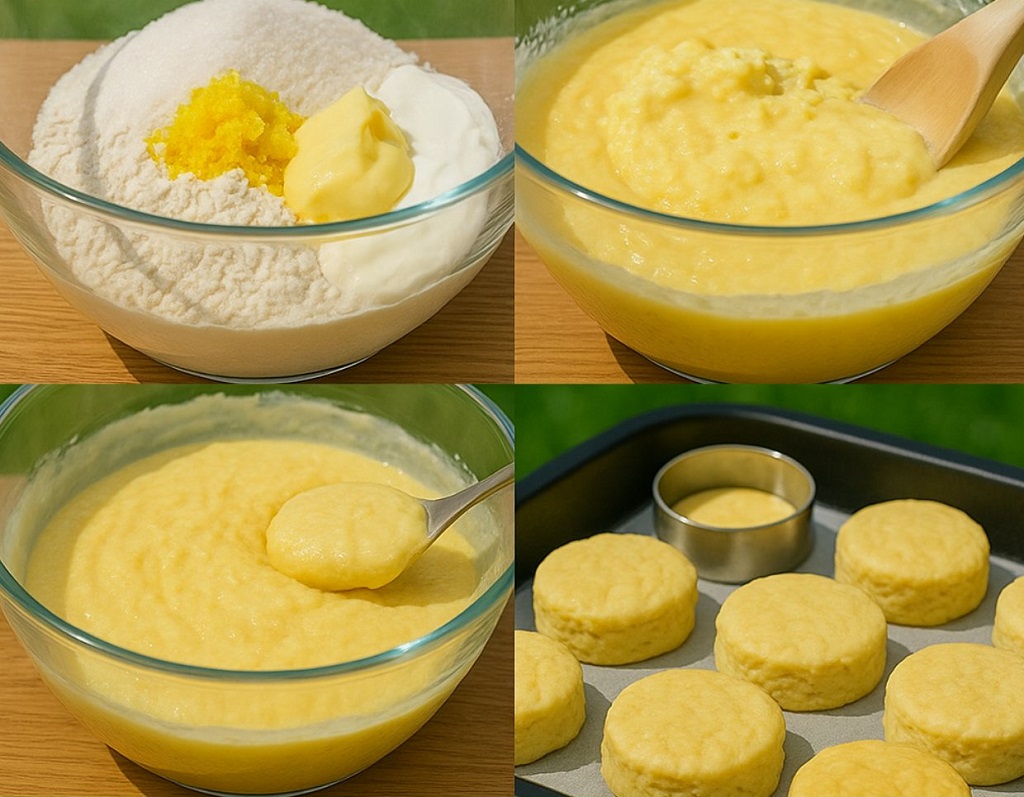These traditional amasi scones are a warm and tender treat that bring comfort to any table. I’ve made this recipe dozens of times especially when cooking for a group or a celebration and it never fails. The use of amasi, a cultured milk popular in South Africa, gives these scones a gentle tang and rich depth of flavor. Even without eggs, they bake up beautifully soft inside and golden on top.
What Makes Amasi Scones So Unique?
- Made without eggs perfect for allergy friendly baking
- Rich and fluffy texture thanks to cultured amasi
- Large batch size great for family gatherings or freezing
- Versatile base for adding fruit, chocolate, or nuts
“These are the most pillowy scones I’ve ever made and you won’t believe they’re egg free!”
Ingredients for Traditional Scones
| Ingredient | Amount |
|---|---|
| All purpose flour | 10 cups |
| Granulated sugar | 1 cup |
| Baking powder | 10 teaspoons |
| Margarine | 500 grams |
| Amasi (cultured milk) | 2 cups |
| Vanilla custard (optional) | 1 cup |
Step by Step to Make Soft Amasi Scones
1: Prep the Oven and Baking Sheet
- Preheat your oven to 400°F (200°C).
- Line a baking sheet with parchment paper or lightly grease it.
2: Mix the Dry Ingredients
- In a very large mixing bowl, whisk together the flour, sugar, and baking powder.
- Ensure the baking powder is evenly distributed for a consistent rise.
3: Cut in the Margarine
- Slice the margarine into small chunks and add it to the flour mixture.
- Using your fingertips, rub the margarine into the dry ingredients until the mixture resembles coarse breadcrumbs.
- This step helps create layers and flakiness in the scones.
4: Add the Amasi
- Pour in the amasi gradually, mixing gently with a spoon or hands until a soft dough forms.
- If using vanilla custard, add it now and mix just until incorporated.
- Do not overmix the dough should be slightly sticky but manageable.
5: Knead Gently
- Turn the dough onto a floured surface and knead lightly just until smooth.
- Too much kneading will make the scones tough aim for about 30 seconds of handling.
6: Cut and Shape
- Roll out the dough to about 1 inch thick.
- Use a round cookie cutter or glass to cut out scones, dipping it in flour between cuts to prevent sticking.
7: Bake Until Golden
- Place the scones on the prepared baking sheet, spaced slightly apart.
- Bake in the preheated oven for 15-20 minutes, or until they are puffed and golden brown on top.
8: Cool and Serve
- Let the scones cool slightly on a rack before serving.
- They’re best enjoyed warm with a slather of jam and a dollop of whipped cream.

Optional Add Ins for More Variety
- Raisins: Fold in 1 cup of raisins for a classic twist.
- Chocolate chips: Use dark or milk chocolate for a sweet treat.
- Chopped nuts: Add 3/4 cup of toasted walnuts or pecans for crunch.
- Spices: Try a teaspoon of cinnamon or cardamom for warm flavor.
Serving Suggestions for Any Time of Day
- Breakfast: Serve warm with butter and marmalade alongside tea or coffee.
- Brunch: Pair with cheese, fruit, and soft boiled eggs for a hearty spread.
- Afternoon Tea: Scones + clotted cream + strawberry jam = classic delight.
- Dessert: Top with vanilla custard or drizzle with honey and chopped nuts.
Chef’s Tips for Perfect Egg Free Scones
- Chill the margarine: Cold margarine creates better rise and flakiness.
- Handle the dough gently: Overworking leads to tough, dense scones.
- Use fresh baking powder: This is your only leavening, so make sure it’s active.
- Don’t skip the parchment: It helps prevent overbrowning on the bottom.
Storage and Freshness
- Scones are best served fresh on the same day they’re baked.
- Store leftovers in an airtight container at room temperature for up to 2 days.
- To refresh, warm briefly in the oven at 300°F for 5-7 minutes.
Nutritional Information (Per Scone)
| Nutrient | Amount |
|---|---|
| Calories | Approximately 250 |
| Fat | 11g |
| Carbohydrates | 35g |
| Sugar | 6g |
| Protein | 4g |
How to Customize Amasi Scones for Any Occasion
These traditional amasi scones are incredibly adaptable. Whether you want something sweet for teatime or savory for breakfast, there’s a way to tweak this base recipe to match the mood. I’ve experimented with dozens of flavor combinations over the years, and these are the ones I return to most often when I want to take the basic scone to the next level.
1. Sweet Flavor Variations
- Cranberry Orange: Add 1 tablespoon orange zest and 1 cup dried cranberries to the dough. Glaze with powdered sugar and orange juice.
- Chocolate Chip: Fold in 1 cup semi sweet chocolate chips. Sprinkle the tops with coarse sugar before baking.
- Cinnamon Swirl: Add 2 teaspoons cinnamon and a swirl of brown sugar paste made with a tablespoon of water and 3 tablespoons brown sugar.
2. Savory Scone Variations
- Cheddar Chive: Mix in 1 cup shredded cheddar cheese and 1/4 cup chopped chives. Brush tops with milk and add a pinch of sea salt before baking.
- Spinach and Feta: Stir in 1/2 cup cooked chopped spinach and 1/2 cup crumbled feta for a Mediterranean style scone.
- Garlic Herb: Use 1 teaspoon garlic powder, 1/2 teaspoon onion powder, and 1 tablespoon chopped rosemary in the dough.
3. Glazes and Finishes
- Sweet glaze: Combine 1/2 cup powdered sugar with 1 tablespoon milk and drizzle over cooled scones.
- Eggless shine: Brush with milk or a little amasi before baking for a golden finish without using egg wash.
- Sugar topping: Sprinkle raw or demerara sugar on top before baking for a crunchy crust.
Serving Scones for Different Meals
Depending on how you prepare them, scones can be suited to everything from a breakfast buffet to a luxurious afternoon tea spread. Here are some pairing and presentation ideas I’ve used for events, brunches, and family weekends.
Breakfast Pairings
- With butter and honey: Simple and satisfying, especially with warm scones right out of the oven.
- With scrambled eggs and avocado: Cut the scones in half and layer with eggs and avocado slices for a savory sandwich.
- With fruit preserves: Serve with strawberry, apricot, or fig jam for a burst of fruity flavor.
Brunch or Lunch
- Scone sandwiches: Use savory versions with fillings like sliced chicken, arugula, and aioli.
- With salad: Pair with a fresh garden salad or roasted vegetable platter for a light and flavorful meal.
- Soup side: Cheddar or herb scones are excellent with tomato or butternut squash soup.
Afternoon Tea
- With whipped cream and jam: A timeless favorite. Serve warm and split in half to fill.
- With lemon curd: The tartness of lemon curd balances the richness of the scone beautifully.
- Paired with rooibos tea: A nod to South African heritage and a lovely aromatic pairing.
My Personal Tips from Years of Scone Baking
As a chef who has baked thousands of scones over the years, here are the practical, experience backed tips that make the biggest difference in outcome:
- Measure flour correctly: Spoon it into your measuring cup and level with a knife. Scooping directly packs too much in and leads to dry scones.
- Cold margarine is key: You want to see little pockets of margarine in the dough they’ll melt during baking and create flakiness.
- Don’t overknead: Kneading more than 30-40 seconds can develop gluten and make your scones chewy instead of tender.
- Use parchment or silicone mats: This helps prevent overbaking and makes cleanup much easier.
- Don’t crowd the baking sheet: Scones need space to rise and expand evenly.
Common Mistakes and How to Fix Them
| Issue | Cause | Solution |
|---|---|---|
| Dry texture | Too much flour or overbaking | Weigh flour if possible and remove scones as soon as tops are golden |
| Flat scones | Too much kneading or old baking powder | Use fresh leavening and handle the dough gently |
| Burned bottoms | Pan too thin or oven too hot | Use parchment or an insulated baking tray |
| Dough too sticky | Too much amasi or humidity | Dust hands and surface lightly with flour when shaping |
Reader Reviews
“I made these scones for my mom’s birthday brunch and everyone loved them! The texture was perfect.” Ntombi M.
“I didn’t have eggs so this recipe was a lifesaver I added raisins and the flavor was amazing.” Josephine R.
“These came out light and fluffy just like bakery scones. The custard addition made them even better!” Thembi K.
FAQs
Can I use buttermilk instead of amasi?
Yes, you can substitute buttermilk for amasi in equal amounts. Both are cultured dairy products and work similarly in creating soft, fluffy scones. Greek yogurt thinned with milk is another alternative if you can’t find amasi or buttermilk.
How do I store leftover scones?
Scones are best enjoyed fresh but can be stored in an airtight container at room temperature for up to 2 days. For longer storage, wrap tightly and freeze for up to 2 months. Reheat in the oven for 5-7 minutes at 300°F (150°C) to restore their texture.
Can I make these scones ahead of time?
Yes! You can prepare the dough, cut out the scones, and freeze them unbaked. When ready to bake, place the frozen scones on a tray and bake directly from frozen, adding 2-4 extra minutes to the baking time.
Why are my scones dry or crumbly?
This usually happens if too much flour is added or if the dough is overmixed. Make sure to spoon and level your flour when measuring and knead the dough just enough to bring it together.
Can I make this recipe in a smaller batch?
Definitely. This recipe is large and designed for gatherings, but you can easily halve all the ingredients for a smaller yield. Use 5 cups flour, 1 cup amasi, 250 grams margarine, and adjust the rest accordingly.
Do these scones rise much in the oven?
Yes. Thanks to the high amount of baking powder, these scones puff up beautifully during baking. Make sure not to press the dough too flat and give them space on the tray to expand.

thank you so much. custard powder or readily made custard?
Wow amazing recipe